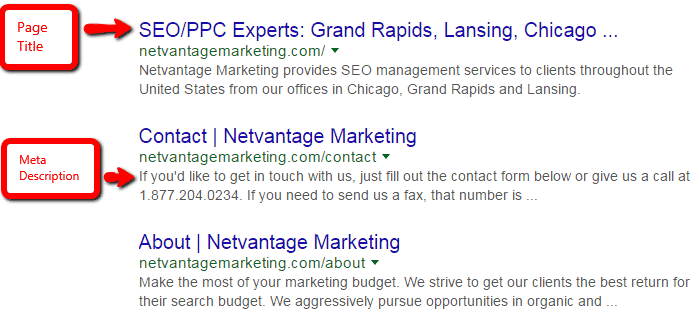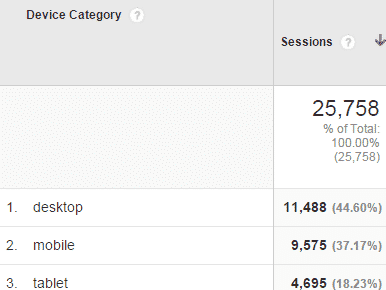This resource is designed to be an evolving SEO guide for businesses in an industrial or manufacturing field. We’ve worked with many different manufacturing and industrial companies, and we know that they aren’t always the easiest and tend to have a tough time with SEO. That said, it is still extremely important to do SEO well, as it has the potential to drive extremely valuable traffic to your website that has the potential to convert to leads.

On-Site
Off-Site
Technical SEO
On-Site
The following are on-site factors to consider for industrial companies. The majority of these tips are applicable to many different types of businesses, not just industrial companies.
Keywords
A keyword would be the phrase used in a search query. It is important to conduct keyword research, as keywords can be incorporated into on-site elements like page titles, meta descriptions and body copy.
When incorporating keywords into on-page factors like the ones listed below, it is important to understand that there is a fine line between under-using and over-using keywords.
There are four very important factors to consider when evaluating keywords:
Relevancy – Obviously, you want to rank for the search queries that are in line with your products or services. Generally one of the easiest factors to assess.
User Intent – Is the user ready to make a decision, or are they just conducting preliminary research?
User intent can be the same for different keywords, so it is important to identify the variations that have the best relevancy, volume and competition levels. For “electric broilers” and “concrete sealants” there are many different keyword variations to consider like “electric steam broilers” and “sealants for concrete.”
Volume – It is important to identify which keyword variations have higher search volumes. In other words, people search for the same things, but say them in a different way.
For example, “Pumps” is searched roughly 110,000 per month in the United States, which is a really high search volume and may sound appealing to an industrial pumps supplier. Upon further research, it’s clear that most people searching for “pumps” are actually searching for ladies shoes. Keywords like “submersible pumps” (5,400 searches) and “hydraulic pumps” (3,600 searches) both have high search volumes are more relevant and likely have good user intent.
Additionally, a keyword can be relevant and have a high value user intent, but no one searches for that keyword. As we like to say, there’s not much value in ranking #1 in a vacuum.
Competition – How competitive is it to rank for the keyword, and how realistic is it to rank for that keyword?
It is also important to understand that users often search for products or services for their industry, and not just for the products or services themselves. For example, a die cutting company may want to rank for both “corrugated die cutting” and “automotive die cutting”. While they could list that they provide corrugated die cutting services to the automotive industry on their Corrugated service page, they would be better off creating a new automotive industry page highlighting their services to businesses in the automotive industry.
The following are some excellent keyword research tools to utilize. A great place to start is to utilize keywordtool.io’s question section. It can give you a sense of common questions and concerns you target audience experiences, which can be used for content generation. You can also read our blog post on keyword generation for a more in-depth look at keyword research.
Page Titles
 Page titles, AKA title tags, are arguably the most important SEO factor to consider. They should incorporate both keywords and the brand name. A format like the following would be appropriate: “Keyword phrase 1, Keyword phrase 2 | Brand Name.”
Page titles, AKA title tags, are arguably the most important SEO factor to consider. They should incorporate both keywords and the brand name. A format like the following would be appropriate: “Keyword phrase 1, Keyword phrase 2 | Brand Name.”
Most search engines stop displaying page titles in Search Engine Results Pages (SERPs) after 65-70 characters, and it is ideal to keep page titles as condensed as possible.
Meta Descriptions
The meta descriptions of pages on your website is also strongly used by search engines in determining rankings, and is fairly easy to tweak to your liking. A few loose rules to follow when writing meta descriptions:
- Your target keyword(s) for the page should be incorporated into the meta description, but it is important to do so in moderation.
- Meta descriptions in results pages generally get cut off at about 155-170 characters, so it is best to aim to make meta descriptions for all pages about that length.
- They are meant to be a brief summary of a page for people to read before viewing the page, so they should be written with that in mind.
Body Copy
It is important to understand the current use of keywords in the body copy of pages and to incorporate keywords as naturally as possible.
One of the biggest mistakes we see is multiple pages using the same text. Google will treat the pages as the same, and it becomes nearly impossible to rank either page well for any keyword.
Search engines like body copy that is as informative and descriptive as possible. Studies have shown that higher word counts in the content of a page typically earn higher positions.
Alt Tags
Alternative text tags can be assigned to images on your website. Originally intended for blind people with screen reader software to understand what image is located on a webpage, search engines use them to understand an image on a page, as they have no way of “seeing” the image.
For an image of a shredder in a field recently I gave the image an alt tag of “agriculture shredding machine harvesting corn.” It is important to not overuse keywords in the alt text. For example, a bad alt text for this image would be “corn shredding machines for sale.” Alt texts should only be used to give a user a better understanding of the context of the image.
Tools to assist with On-Site SEO
Google Adwords Keyword Planner – Get search volumes and competitive analysis for a list of keywords.
Google Webmaster Tools – Helps with all aspects of your website, including identifying bad pages, pages with too short meta descriptions, duplicate page titles, and a whole lot more.
Screaming Frog SEO Spider – Strange name. Awesome tool. Helps identify important on-site factors like page titles, meta descriptions, http status codes and much more.
MozBar Browser Extension – Makes it easy to see on page elements without having to leave your browser.
Off-Site
Google My Business
Taking control of how your business is listed locally in Google is easy. Google My Business is Google’s platform for allowing business owners to update their business listing with up to date and accurate information. Getting your business listed on Google is easy. A few basic tips:
- Ensure everything is accurate: Address, phone number, business name
- Write a detailed description – similar to what you would write on your About Us website page
- Upload photos of your business location. You can also upload product and service photos.
- Choose categories that are relevant to your business and are provided as options by Google. In other words, don’t use custom categories. Use this tool to find categories relevant to your business.
Link Building Opportunities
Already Existing Connections
Some of the best links your business can gain is from businesses or organizations that you are already connected with. Some examples would include:
- Distributors
- Associations you are a member of
- Organizations you sponsor or donate to
- Company accountant
Competitor Analysis
Looking at where your competitors get their links from typically uncovers some great opportunities for your industrial company. Pretty much all backlink analyzers like Majestic SEO, Moz and Ahrefs require a monthly subscription.
To get a quick sense of where your competitors are getting mentions and links from, you can run a simple search in Google: “Competitor name -site:competitordomain.com”
Directories
General Directories
A list of some directories that are valuable to be in for any business in any industry. They are important for increasing the. Google looks for location consistencies in the Name, Address and Phone number of a business, AKA your NAP listings.
Industrial Directories
The following are some industrial focused directories that are typically beneficial to be included in.
Location specific directories provide value in that they verify to Google that your business has a physical location and is in operation. If your company is based in Sacramento, CA you can use the following search queries to identify directories that may accept your business:
Technical SEO
Sitemap
Sitemaps make it easier for search engines to crawl your website and add each of your pages to their index as quickly as possible. You should make sure that your sitemap is submitted to Google through Google Webmaster Tools, as well as to Bing through Bing Webmaster Tools.
Site Speed
Search engines want their users to arrive at websites that are fast and user friendly, so a slow loading website is an issue that can hinder search engine rankings. The best tool to check to see if your website is fast enough for Google’s standards is their PageSpeed Insights Tool. Not compressing images, landing page redirects, and not enabling compression are just some of the issues that can cause a low grade from Google.
It isn’t realistic to get a perfect score, but doing anything you can to get your score in the green and definitely out of the red is ideal.
Mobile Friendly
 With increasing percentages of people accessing websites from mobile devices, Google wants its mobile users to access websites that are easy to navigate. For that reason they have encourage websites to display mobile friendly websites.
With increasing percentages of people accessing websites from mobile devices, Google wants its mobile users to access websites that are easy to navigate. For that reason they have encourage websites to display mobile friendly websites.
As of now:
- Google is more likely to display a mobile friendly website ahead of a non-mobile friendly website in search engine rankings for people using mobile devices.
- Google uses separate algorithms for mobile website visitors and desktop visitors. If you do not have a mobile friendly website, it will not impact keyword rankings for desktop and tablet users.
It is important to identify the breakdown of devices used to access your website and to see how that breakdown has changed over time. This data is available in Google Analytics.
Structured Data
Setting up structured data is particularly important for industrial businesses operating in a geographic zone. Google Webmaster Tools makes it easy with the data highlighter tool. This makes it easier to better understand information that you display on your website, such as addresses, phone numbers, hours of operation, and product reviews and ratings.

Leave a Reply